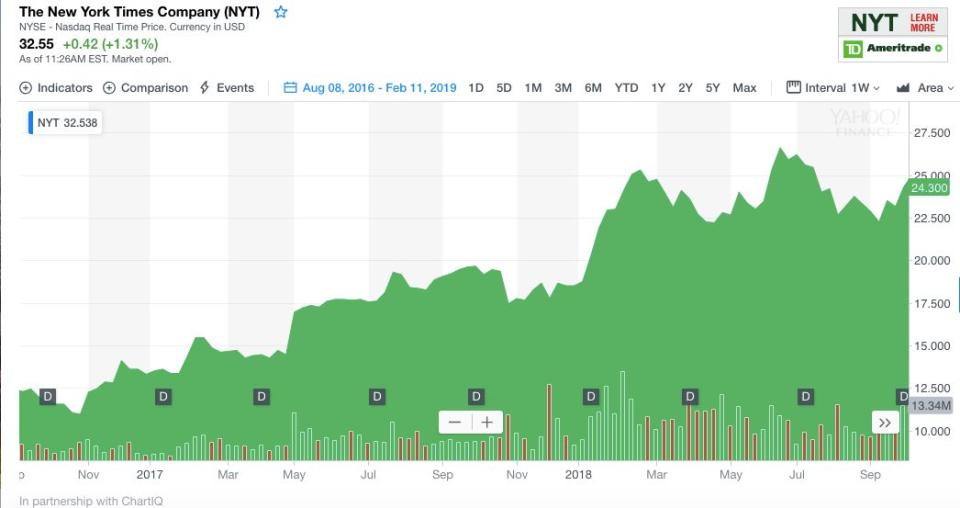How Donald Trump strengthened The New York Times and grew a Mexican billionaire's fortune
I’ve been thinking about The New York Times lately, and not so much because “the failing New York Times” is in Donald Trump’s crosshairs—although there is a connection (more on that in a second), but because the Times has become emblematic of two things I’m keenly interested in, namely, the digital revolution transforming the media business, and making money in the stock market.
Simply put, the Times has had a bit of success with the former, which has led to a bit of success with the latter.
Ten years ago though the opposite was true. It was the worst of times for the Times. The company that owned the Paper, as it is called by insiders, actually was failing, both in terms of its business model and as an investment.
In those dark days—the nadir of the Great Recession—it was legitimate and even logical to call into question the Times as a going concern. Advertising was tanking and so too print subscriptions. An ambitious paywall scheme—launched in 2005—was an “embarrassing flop,”a former Times editor told me.
‘The paper’s future doesn’t look good’
“End Times” was the headline of a piece in the Atlantic (Jan/Feb 2009), which asked and (partly) answered this question: “...what if The New York Times goes out of business—like, this May? It’s certainly plausible. Earnings reports released by the New York Times Company in October indicate that drastic measures will have to be taken over the next five months or the paper will default … the paper’s future doesn’t look good.”

But a funny thing happened on the way to bankruptcy court.
An unlikely savior emerged you may recall, in the form of Mexican billionaire Carlos Slim Helu. The previous September, (that is September 2008, when the U.S. financial system was melting down), Slim bought a 6.4% stake in The New York Times Company, or 9.1 million shares, worth some $127 million. (The stock was then around $13.)
Immediately after Slim’s purchase, the situation became much worse, both for the global economy and as noted for the Times. But as talk of bankruptcy amplified, Slim stepped up again. In January he loaned the company $250 million “in the form of six-year notes with warrants that are convertible into common shares, the company said in a statement. The notes also carry a 14 percent interest rate, [emphasis added] with 11 percent paid in cash and 3 percent in additional bonds,” the Times dutifully reported on itself.
Still the market was unimpressed. In February 2009, New York Times stock dropped to a low of $3 and change. The Atlantic piece looked prescient and Slim’s investment of some $327 million appeared to be lost money.
Billionaires like Slim buy low
Before we tell the tale of the Times’s reversal of fortune, a quick note about Carlos Slim—with a reported net worth of some $60 billion, one of the richest human beings on the planet—and other successful investors. They buy low. They buy when everyone else is running for the exits. When everyone thinks they are making a huge mistake. They see things others don’t and they make big bets and, yes, often extract onerous terms, because when they are making their offers, no one else is. (Warren Buffett has been known to do this.) It’s also worth noting that Slim’s sugar daddy investment preceded similar moves by Jeff Bezos (the Washington Post), Laurene Powell Jobs (the Atlantic), and Marc Benioff (Time Magazine) by many years.
Okay, back to our story. The turnaround at the Times didn’t happen overnight and mistakes were made along the way. The company’s stock mostly traded below $10 well into 2013. It took time for then-publisher Arthur Sulzberger Jr. (yes him), CEO Mark Thompson, and others to figure things out, like how to integrate the digital and print newsrooms, sell extraneous properties like the Boston Globe, implement aggressive sales strategies and marketing campaigns and most importantly create a digital business model highlighted by a new, metered paywall—established in 2011—that slowly but surely worked.

‘A bull market for news’
Still the Times’s stock didn’t begin its climb from the very lowest of double digits to triple that, until—you guessed it—November of 2016. If anyone needs a graphic visual of what the “Trump bump” did to the news business, look no further than a two-and-quarter-year NYT stock chart. As Silicon Valley billionaire Peter Thiel told me not long ago, “we are living in a bull market for news”—and it has been created almost entirely by Donald Trump. (It hasn’t been a bull market for all news orgs, though. While the Times and other big papers and cable TV news networks have thrived, regional newspapers and some digital players continue to struggle.) The Times benefited by tapping into its readers’ anger and angst, and by extensive and investigative reporting on Trump once he was elected. The Paper was also well served by sticking with and even enhancing all manner of deeply reported pieces and storytelling.

Earlier this month, the Times posted some numbers that illustrated the results of this growing customer interest, numbers that caught the stock market by surprise. Digital revenue grew to more than $700 million. Digital subscribers climbed to 3.3 million up 27% from 2017. And maybe the biggest news of all: “Digital advertising surpassed print advertising for the first time in the fourth quarter, jumping 23 percent to $103 million.” Wow! The lines on the chart finally crossed. Now that’s a landmark moment.
And so the Times’s stock has jumped from $22 on December 24 to its current price of $32—a 14-and-a-half-year high. (Remember the stock was at $3 and change almost exactly 10 years ago—up nearly 10X since then.)
Now let’s return to Carlos Slim and his investment. How has he fared over this long decade? Well, pretty well. Yahoo Finance’s Max Zahn crunched the numbers. It’s a complex and sophisticated series of investments, but here’s what things look like. According to SEC filings (Form 4s), Slim has sold at least $270 million of stock since he began paring his stake in 2017. He’s also been paid at least $11 million in dividends. Plus, his $250 million loan was repaid in 2011 after $122 million in interest payments and an additional $29 million, likely a prepayment penalty.
Slim invested $377 million (the initial investment of $127 million plus the $250 million loan), and he later paid $101 million to exercise stock warrants—for a total investment of $478 million. Now his $250 million loan has been paid back, plus he has received some $432 million in stock sales, interest payments, dividends, and fees ($270 million + $122 million + $11 million + $29 million). Oh, and the Slim family still held over 16 million shares worth more than $517 million, as of the end of 2018. So Slim put in $478 million and now apparently has $1.2 billion (as of the end of 2018.) Not earth shattering but not shabby either, especially considering he made this kind of dough investing in The New York Times.
It’s worth noting that there may be facets of this dealmaking that we aren’t seeing. Slim’s spokesperson Arturo Elías Ayub did not respond to multiple requests for comment.
A Times spokesperson emailed us: “Carlos Slim became a shareholder of The New York Times Company at a critical time in the company's history. Today, the company has a strong balance sheet and rapidly growing digital revenues. We are grateful for Mr. Slim's confidence and support of the company.”
Some takeaways: While there is no current or apparent animosity between Trump and Slim (the two have met since Trump’s election) the way there is between Trump and Jeff Bezos—whose Washington Post has also been greatly aided by Trump’s election—it is beyond ironic that Donald Trump helped make the richest man in Mexico even richer.
It’s just as ironic—and not lost on Trump—that he helped save The New York Times. (It’s probably true that the Times would be in better shape now than in 2009 even if Hillary Clinton was elected, but it is also probably true that the Paper is even healthier because Trump was elected.)
It’s too early to declare total victory for The New York Times—for one thing what happens when Trump is no longer president? But it’s fair to say the Paper has been saved for now, as it appears to have found a path down the road to digital transformation.
And along the way Carlos Slim made many hundreds of millions of dollars.
Who among us saw that coming in February 2009?
Andy Serwer is editor-in-chief of Yahoo Finance.
Read more:
Michael Bloomberg could 'absolutely' defeat Trump, says major Democratic donor Steven Rattner
A simple, yet radical solution to solve Facebook’s problems
Netflix can 'continue to raise prices' amid new competition, says media mogul Barry Diller

 Yahoo Finance
Yahoo Finance